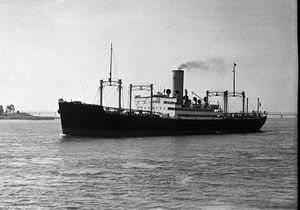SS Beaverford

Beaverford
|
|
| History | |
|---|---|
| Name: | SS Beaverford |
| Owner: |
|
| Port of registry: | London, |
| Route: | London to Montreal (Apr-Nov), London to Saint John, New Brunswick and Halifax (Nov-Apr) |
| Builder: | Barclay Curle, Glasgow |
| Yard number: | 617 |
| Launched: | 27 October 1927 |
| Maiden voyage: | 21 January 1928 |
| Identification: |
|
| Fate: | Sunk in battle by shell fire and torpedo from German pocket battleship Admiral Scheer 5 November 1940 |
| General characteristics | |
| Class and type: | Cargo liner |
| Tonnage: | 1,042 GRT |
| Length: | 503 ft (153 m) |
| Beam: | 62 ft (19 m) |
| Propulsion: | Twin Screw, steam turbines |
| Speed: | 15 kn (28 km/h) |
| Capacity: | 12 passengers |
| Crew: | 77 |
| Sensors and processing systems: |
Echo Sounder, Wireless Direction Finder |
| Armament: | 1940, fitted with one 4 inch & one 3 inch guns |
| Notes: | Specification Source: “Beaverford”, ‘ ‘Lloyds Register’ ‘, 1940 |
SS Beaverford was a cargo liner operated by the Canadian Pacific Steamship Company. Built in 1928 for freight service between Montreal and London, she was sunk in 5 November 1940 during the Battle of Convoy HX-84 while fighting to allow other ships in the convoy to escape the German pocket battleship Admiral Scheer.
Beaverford was the first of five cargo ships built by Canadian Pacific in 1927 and 1928 including sister ships Beaverdale, Beaverburn, Beaverhill and Beaverbrae. Designed to carry 10,000 deadweight tons of cargo as well as 12 passengers, they were fitted with 80,000 cubic feet of insulated cargo space and 20,000 cubic feet of refrigerated cargo spaces for meat and fruit. Their twin screws were powered by six Parson steam turbines and were among the most efficient steam engines of their time. Their boilers were fitted with Erith-Roe mechanical stokers, the first automatic stokers in the British merchant service. The beaver ships maintained a fast cargo schedule between London and Montreal in the summer and London and Saint John, New Brunswick and Halifax, Nova Scotia in the winter. Registered in London with a mostly British crew, the ship was adopted by the Downhills Central School near the London docks in Tottenham through the British Ships Adoption Society with students touring the ship when it was in port and receiving visits from the ship’s officers. On July 2, 1938 Beaverford rescued 400 passengers from the Cunard Liner Ascania, which had run aground in the St. Lawrence River, near Bic Island, Quebec.
With the onset of war, the fast and modern beaver ships were requisitioned by the British Admiralty to carry high-value stores. Beaverford was fitted with two guns for self-defence, a four-inch gun on the stern and a three-inch gun on the bow. She remained owned by Canadian Pacific with a Merchant Navy crew, along with two with two DEMS gunners.Beaverford sailed from Halifax, Nova Scotia on October 28, 1940 as part of Convoy HX-84. Beaverford was carrying refined aluminum and copper, maize, meats and cheese and a large consignment of ammunition in her holds along with a deck cargo of timber and crated aircraft. Beaverford had a crew of 77. Most were from Britain but three were Canadians including one of the two gunners. The ship was commanded by the 60-year-old Captain Hugh Pettigrew from Coatbridge, near Glasgow, who had sailed with Canadian Pacific since 1910 and was a veteran of naval actions at Gallipoli and had survived the torpedoing of HMS Medora in 1918.
...
Wikipedia
